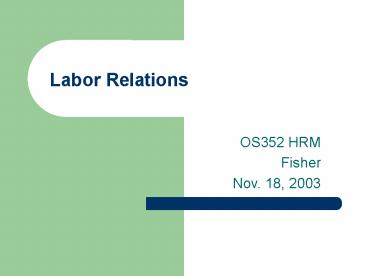Labor Relations - PowerPoint PPT Presentation
Title:
Labor Relations
Description:
... Management Relations. Railway Labor Act 1926. National Labor Relations Act ... Topic: More on labor relations. For next time, explore the AFL-CIO website ... – PowerPoint PPT presentation
Number of Views:640
Avg rating:3.0/5.0
Title: Labor Relations
1
Labor Relations
- OS352 HRM
- Fisher
- Nov. 18, 2003
2
Agenda
- Hand out final essay questions
- History of unions
- Basic union concepts and laws
- Organizing process
- Next class
- Bargaining and contract administration processes
- Current issues with unions
3
Final essay questions
- Due December 8 at 500
- Submit electronically via Turnitin.com
- Class ID 1076184
- Password HRsec2
- Choose 2 of 4 questions
- Use at least three external sources in each
answer - Individual assignment
4
History of Unions
- Started in late 1700s in US (printers,
carpenters, etc.) - Purpose was to protect worker rights (pay,
working hours) - Less effective in depressions
- Decrease in union membership attributed to
increase in service sector, high tech jobs
5
Current Status
- Declining membership
- In 1945, 35.5 of workforce was unionized (high
point) - Currently 13.5 of the workforce (Bureau of Labor
Statistics, January 2002) - Largest union in US is AFL-CIO
- Formed in 1955
- Over 13 million members
- Goal is to increase membership by 3 a year
6
Benefits of Unions
- For employees
- Higher wages
- Better benefits
- Increased job security
- More job training and skill development
- For employers (!)
- Potential for wage concessions
- Cooperation in joint workplace efforts
7
Laws Governing Labor-Management Relations
- Railway Labor Act 1926
- National Labor Relations Act (Wagner Act) 1935
- Labor Management Relations Act (Taft-Hartley) -
1947 - Landrum-Griffin Act - 1959
8
NLRB
- National Labor Relations Board
- Established in 1935 by NLRA
- Guarantees the right of employees to organize and
bargain collectively with employer - Major functions
- Provide certification election oversight
- Prevent and remedy unfair labor practices
- Does not act on its own
9
The Certification Process
Determination of bargaining unit by NLRB
Union campaign for authorization cards
Union contactwith employees
Request for election
Certification of union and start of collective
bargaining
Pre-election campaign
Elections
Bargaining Unit a group of employees certified
by the NLRB to be able to be included in the
union.
Source William D. Todor, Professor of Human
Resource Management, The Ohio State University
10
Voting process
- Monitored by NLRB
- Employers are not allowed to intimidate workers
- Delta flight attendants case
- 5,520 Yes votes, 89 No votes
- 19,003 eligible voters
- Non-votes count as No
- Delta accused of interfering with election
11
What can management do?
- Discuss the history of unions and make factual
statements about strikes, violence, or the loss
of jobs at plants that have unionized. - Discuss their own experience with unions.
- Advise workers about the costs of joining and
belonging to unions. - Remind employees of the company benefits and
wages they receive without having to pay union
dues. - Explain that union representation will not
protect workers against discharge for cause. - Advise employees that unions often resort to work
stoppage to press their demands and that such
tactics can cost them money.
12
Unfair Labor Practices (Section 8 of NLRA)
- Interference, restraint, or coercion to prevent
employees from organizing or bargaining
collectively - Domination or interference with union or
providing financial support for it. - Discrimination against employees in order to
discourage union membership. - Discharging or retaliating against an employee
who has filed charges or given testimony under
the NLRA. - Refusal to bargain collectively with a
representative of employees (good faith
bargaining).
13
Right-to-Work Laws
- State laws prohibiting
- Union shops Employees are required to join the
union within a certain amount of time (30 days)
after beginning employment. - Agency shops Employees are required to pay union
dues but do not have to join the union. - Maintenance of membership Employees who do join
the union are required to remain members for a
certain period of time. - New York does not have right-to-work laws
14
For next class
- Topic More on labor relations
- For next time, explore the AFL-CIO website
- Identify one unionized facility in the North
Country (company and union)































